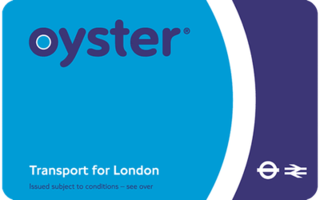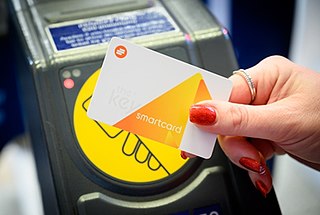
The history of public transport authorities in London details the various organisations that have been responsible for the public transport network in and around London, England - including buses, coaches, trams, trolleybuses, Docklands Light Railway, and the London Underground.

Transport for London (TfL) is a local government body responsible for most of the transport network in London, United Kingdom.

The Oyster card is a payment method for public transport in London in England, United Kingdom. A standard Oyster card is a blue credit-card-sized stored-value contactless smart card. It is promoted by Transport for London (TfL) and can be used on travel modes across London including London Buses, London Underground, the Docklands Light Railway (DLR), London Overground, Tramlink, some river boat services, and most National Rail services within the London fare zones. Since its introduction in June 2003, more than 86 million cards have been used.

The Travelcard is an inter-modal travel ticket for unlimited use on the London Underground, London Overground, Elizabeth line, Docklands Light Railway, London Trams, London Buses and National Rail services in the Greater London area. Travelcards can be purchased for a period of time varying from one day to a year, from Transport for London, National Rail and their agents. Depending on where it is purchased, and the length of validity, a Travelcard is either printed on a paper ticket with a magnetic stripe or encoded onto an Oyster card, Transport for London's contactless electronic smart card, or an ITSO smartcard issued by a National Rail train operating company. The cost of a Travelcard is determined by the area it covers and, for this purpose, London is divided into a number of fare zones. The Travelcard season ticket for unlimited travel on London Buses and the London Underground was launched on 22 May 1983 by London Transport. One Day Travelcards and validity on other transport modes were added from 1984 onwards. The introduction of the Travelcard caused an increase in patronage and reduced the number of tickets that needed to be purchased by passengers.

The Stansted Express is a direct train service linking London Liverpool Street to London Stansted Airport. It is a sub-brand of Greater Anglia, the current franchise operator of the East Anglia franchise.

Dartford railway station serves the town of Dartford in Kent, England. It is 17 miles 12 chains (27.6 km) down the line from London Charing Cross. Train services from the station are operated by Southeastern and Thameslink. Southeastern also manages the station. Dartford is a major interchange station in the North Kent region of the Southeastern network. Ticket barriers control access to the platforms.

Blackhorse Road is an interchange station, located at the junction of Blackhorse Road/Blackhorse Lane with Forest Road in Walthamstow, London for London Underground and London Overground services.

London Buses is the subsidiary of Transport for London (TfL) that manages most bus services in London, England. It was formed following the Greater London Authority Act 1999 that transferred control of London Regional Transport (LRT) bus services to TfL, controlled by the Mayor of London.

Drayton Green railway station is in the London Borough of Ealing in west London, and is in Travelcard Zone 4. It is on the Greenford branch line 41 chains (0.82 km) north of West Ealing where it joins the Great Western Main Line at 7 miles 7 chains (11.4 km) from London Paddington.

Salfords railway station serves the village of Salfords in Surrey, England. The station is sometimes shown as Salfords (Surrey) in timetables to differentiate it from the two stations in Salford, Greater Manchester. It is on the Brighton Main Line, 23 miles 37 chains (37.8 km) down the line from London Bridge via Redhill and is managed by Southern. Train services are provided by Thameslink and Southern.

Earlswood railway station serves Earlswood, south of Redhill, in Surrey, England. It is on the Brighton Main Line, 21 miles 50 chains (34.8 km) down the line from London Bridge via Redhill and south of the junction between the Redhill line and the Quarry line. Train services are provided by Thameslink and Southern.
The London Underground and Docklands Light Railway (DLR) metro systems of London, England uses a mix of paper and electronic smart-card ticketing.

London has an extensive and developed transport network which includes both public and private services. Journeys made by public transport systems account for 37% of London's journeys while private services accounted for 36% of journeys, walking 24% and cycling 2%,according to numbers from 2017. London's public transport network serves as the central hub for the United Kingdom in rail, air and road transport.

Multivía is a contactless card designed for paying the travel fares in the mass transport system Transantiago, in Santiago, the capital of Chile. Tarjeta Bip! or Bip! Card is a plastic card equipped with a chip, that automatically discounts the cost of a travel when passing the card near a contactless card reader.
London Regional Transport (LRT) was the organisation responsible for most of the public transport network in London, England, between 1984 and 2000. In common with all London transport authorities from 1933 to 2000, the public name and operational brand of the organisation was London Transport from 1989, but until then it traded as LRT. This policy was reversed after the appointment of Sir Wilfrid Newton in 1989, who also abolished the recently devised LRT logo and restored the traditional roundel.

A transit pass or travel card, often referred to as a bus pass or train pass etc., is a ticket that allows a passenger of the service to take either a certain number of pre-purchased trips or unlimited trips within a fixed period of time.

The Key is a contactless ITSO-compatible smartcard developed by the Go-Ahead Group used on buses, trains and other forms of public transport across various areas of the United Kingdom.
Fare capping is a feature of public transport fare collection systems. Fare capping credits the cost of fares for individual trips towards the cost of an unlimited pass, limiting the cost of fares that passengers pay.















